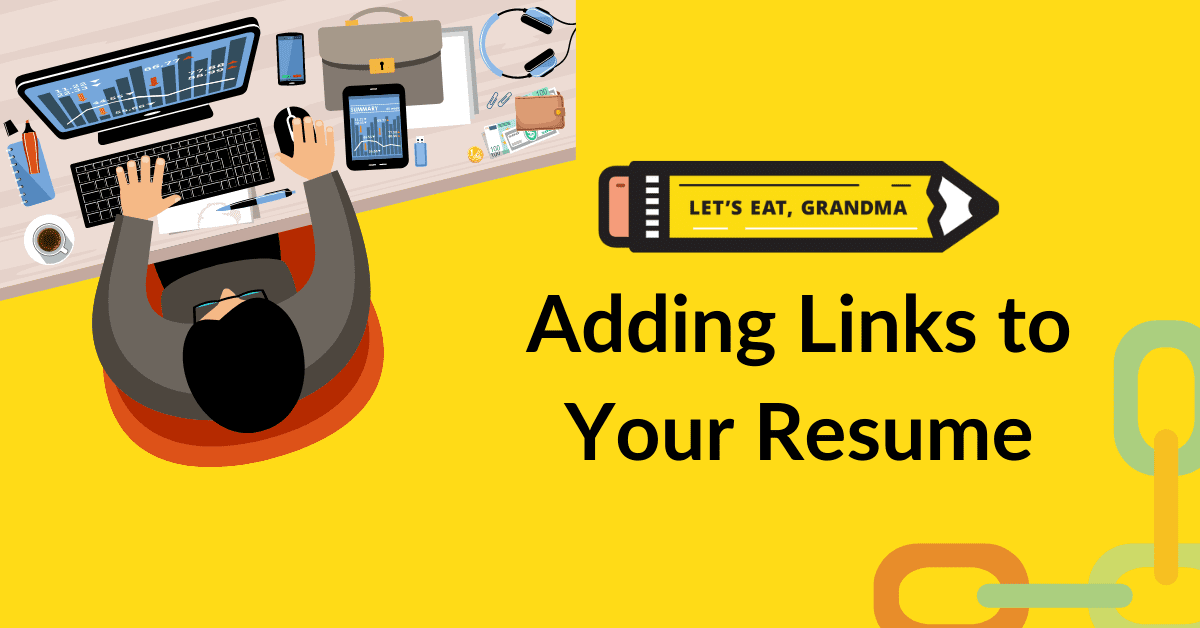How to Add Links to Your Resume: LinkedIn, Github, and More

Since virtually all resumes are now viewed on screens, adding links to your resume is not only acceptable, it’s recommended in many cases. This blog will show you when and how to include links in your resume.
By: Tonyia Cone | Contributor for Let’s Eat, Grandma
Many job seekers aren’t sure about adding links to their resume.
Using a link in a resume is most often effective for people with a particular supplement like a portfolio that showcases some of their work better than a resume can.
However, many types of job seekers benefit from adding links, such as to their LinkedIn and GitHub profiles, that show their expertise and set themselves apart.
How can links help make your resume stronger?
Tired of not landing interviews?
Get our free 3-step guide to writing better resume bullet points, featuring 70 ideas for metrics you can use!
Including Links in Your Resume Header
LinkedIn profile

Including links to your LinkedIn and GitHub profiles, portfolios, and other professional web assets saves the hiring manager a step. Photo by Benjamin Dada on Unsplash
If you have a fully completed, up-to-date LinkedIn profile — and you definitely should — include a link to your LinkedIn profile in your resume header.
Hiring managers and recruiters rely on the platform to find and evaluate candidates. After reviewing your resume, the first thing many recruiters do is search for your LinkedIn profile. Including a link to your profile saves them a step, which everyone appreciates!
And don’t forget to customize your LinkedIn URL! This will make the address easier to read and copy/paste and take up less space on your resume.
GitHub
Have code on GitHub? Software engineers with coding projects on GitHub or other code-hosting platforms should definitely include those links in the resume header.
Not only does it provide hiring managers with an example of your code, it shows that you are driven to work on side projects because of a devotion to learning and developing your professional skills.
Portfolio or personal website
Creative professionals like photographers, writers, and web, UI, and UX designers sometimes find it hard to include metrics on their resumes since there is not always a quantifiable impact.
For those whose work needs to speak for itself, linking to a creative portfolio or personal website in the resume header is a great alternative. A creative portfolio can give an employer a tangible sense of your capabilities, while a personal website is an opportunity for you to build a strong personal brand.
While writing resumes for Let’s Eat, Grandma, I saw how portfolios and websites were a particularly powerful tool for professionals such as advertising copywriters and graphic designers.
I also worked with a theme park engineer who worked with the biggest companies in his industry. Reading about his experience was impressive, but seeing images of his work left an unforgettable visual impact.
Social media profiles

Only include social media links if they’re relevant to the job. Photo by Sara Kurfeß on Unsplash
Demand for social media managers is growing and many marketing positions include a social media component. If a social media profile adds professional value to your resume, i.e., if your personal Twitter or side-hustle Instagram show that you have strong social media strategy and writing expertise, and the role you want requires these skills, it can be really beneficial to link to those social media profiles.
Including Links Elsewhere in Your Resume
Once you move on from your header, it may make sense to include links in other resume sections as well. If your results-based bullet points reference a digital project, article, or social media post, it can be helpful to link to it.
A client I worked with was named in the Forbes “Under 40” list for his global region, and we hyperlinked that super cool award.
Quick tip: There’s a myth that surfaces every once in a while that links are not ATS-friendly. As long as you are using universal fonts and other standard formatting, this has no basis in fact.
Just Link It!
As long as you only include links that are professionally relevant, helpful to a hiring manager or recruiter, and cast you in the best light, like everything on the valuable real estate that is your resume, you’re good to go.
And one final, very important note: Every time you submit your resume, while proofreading your document for typos and other mistakes, don’t forget to make sure all your links still work!
Ready for more job search help?
Sign up for a free Senior Writer Resume Critique to see what's holding you back from landing interviews. One of our top professional resume writers will give you personalized feedback on the top 3 items you can improve based on our expert practices!
